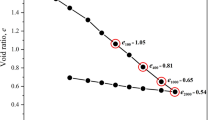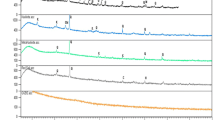Abstract
In this study, the pore structure of alkali-activated fly ash (AAFA) pastes characterized by different techniques, including mercury intrusion porosimetry (MIP), nitrogen adsorption and image analysis (based on backscattered electron images), was evaluated and compared critically. The degree of reaction of fly ash in AAFA pastes was derived from image analysis. It was found that due to a significant “ink-bottle” effect, the pore diameter of capillary pores derived from MIP was two orders of magnitude smaller than the size determined by image analysis. MIP and nitrogen adsorption results showed different peaks corresponding to the gel pores of AAFA pastes. Based on the experimental results, image analysis is regarded as a reliable technique for the characterization of large pores (> 1 μm) in AAFA pastes. Nitrogen adsorption is more suitable to characterize small pores (< 0.1 μm) in AAFA than MIP, and MIP data should be carefully interpreted, preferably in combination with other characterization techniques.











Similar content being viewed by others
References
Provis JL, Van Deventer J (2009) Geopolymers: structure, processing, properties and industrial applications. Woodhead Publ. Limited, Sawston
Duxson P, Provis JL, Lukey GC, Van Deventer JSJ (2007) The role of inorganic polymer technology in the development of ‘green concrete’. Cem Concr Res 37:1590–1597
Provis JL, Deventer JSJV (2014) Alkali activated materials. Springer, Dordrecht
Romagnoli M (2015) Handbook of alkali-activated cements, mortars and concretes
Aligizaki KK (2005) Pore structure of cement-based materials: testing, interpretation, and requirements. CRC Press, Boca Raton
Diamond S (2000) Mercury porosimetry: an inappropriate method for the measurement of pore size distributions in cement-based materials. Cem Concr Res 30:1517–1525
Ma H (2014) Mercury intrusion porosimetry in concrete technology: tips in measurement, pore structure parameter acquisition and application. J Porous Mater 21:207–215
Zeng Q, Li K, Fen-Chong T, Dangla P (2012) Analysis of pore structure, contact angle and pore entrapment of blended cement pastes from mercury porosimetry data. Cem Concr Compos 34:1053–1060
Joyner LG, Barrett EP, Skold R (1951) The determination of pore volume and area distributions in porous substances. II. Comparison between nitrogen isotherm and mercury porosimeter methods. J Am Chem Soc 73:373–380
Gerhardt R (1988) As review of conventional and non-conventional pore characterization techniques. Mrs Online Proceedings Library Archive, 137
Aligizaki K (2005) Pore structure of cement-based materials: testing interpretation and requirements. Taylor & Francis, London
Haha MB, Weerdt KD, Lothenbach B (2010) Quantification of the degree of reaction of fly ash. Cem Concr Res 40:1620–1629
Guang YE (2003) Experimental study and numerical simulation of the development of the microstructure and permeability of cementitious materials. J Colloid Interface Sci 262:149–161
Ma Y, Hu J, Ye G (2012) The effect of activating solution on the mechanical strength, reaction rate, mineralogy, and microstructure of alkali-activated fly ash. J Mater Sci 47:4568–4578. https://doi.org/10.1007/s10853-012-6316-3
Scrivener K, Snellings R, Lothenbach B (2016) A practical guide to microstructural analysis of cementitious materials. CRC Press, Boca Raton
Ye G (2003) The microstructure and permeability of cementitious materials. Delft University of Technology, Delft
Washburn EW (1921) The dynamics of capillary flow. Phys Rev 17:273
Ellison AH, Klemm R, Schwartz AM, Grubb L, Petrash DA (1967) Contact angles of mercury on various surfaces and the effect of temperature. J Chem Eng Data 12:607–609
Gerhardt R (1989) A review of conventional and non-conventional pore characterization techniques. Mater. Res. Soc. Symposium Proceedings, 137, Pore structure and permeability of cementitious materials, Cambridge Univ Press, pp 75–82
Barrett EP, Joyner LG, Halenda PP (1951) The determination of pore volume and area distributions in porous substances. I. Computations from nitrogen isotherms. J Am Chem Soc 73:373–380
Scrivener K, Füllmann T, Gallucci E, Walenta G, Bermejo E (2004) Quantitative study of Portland cement hydration by X-ray diffraction/Rietveld analysis and independent methods. Cem Concr Res 34:1541–1547
Diamond S, Leeman ME (1994) Pore size distributions in hardened cement paste by SEM image analysis. Mrs Proceedings, 370
Ridler TW, Calvard S (2007) Picture thresholding using an iterative selection method. IEEE Trans Syst Man Cybern 8:630–632
Lange DA, Jennings HM, Shah SP (1994) Image analysis techniques for characterization of pore structure of cement-based materials. Cem Concr Res 24:841–853
Lloyd RR, Provis JL, Smeaton KJ, van Deventer JSJ (2009) Spatial distribution of pores in fly ash-based inorganic polymer gels visualised by Wood’s metal intrusion. Microporous Mesoporous Mater 126:32–39
Ismail I, Bernal SA, Provis JL, Nicolas RS, Hamdan S, Deventer JSJV (2014) Modification of phase evolution in alkali-activated blast furnace slag by the incorporation of fly ash. Cem Concr Compos 45:125–135
Das S, Yang P, Singh SS, Mertens JCE, Xiao X, Chawla N, Neithalath N (2015) Effective properties of a fly ash geopolymer: synergistic application of X-ray synchrotron tomography, nanoindentation, and homogenization models. Cem Concr Res 78:252–262
Criado M, Fernandez-Jimenez A, de la Torre AG, Aranda MAG, Palomo A (2007) An XRD study of the effect of the SiO2/Na2O ratio on the alkali activation of fly ash. Cem Concr Res 37:671–679
Criado M, Fernandez-Jimenez A, Palomo A, Sobrados I, Sanz J (2008) Effect of the Sio(2)/Na2O ratio on the alkali activation of fly ash. Part II: Si-29 MAS-NMR Survey. Microporous Mesoporous Mater 109:525–534
Rees CA, Provis JL, Lukey GC, van Deventer JSJ (2007) In situ ATR-FTIR study of the early stages of fly ash geopolymer gel formation. Langmuir 23:9076–9082
Acknowledgements
The authors thank the China Scholarship Council for the financial support to the first author’s study in The Netherlands. We also thank the National High Technology Research and Development Program (“863 Program”, SS2015AA030801), National Natural Science Foundation of China (51402057, 51561135012), Science and Technology Project of Guangdong Province (2016B05051004), Guangzhou Education Bureau Foundation (1201610460), State Key Laboratory of Silicate Materials for Architectures Foundation (SYSJJ2017-05), Pearl River S&T Nova Program of Guangzhou (201506010004) and Australian Research Council Discovery Project (1006016) for funding the project. We would like to thank Professor Klaas van Breugel for his ultimate support and guidance to the project.
Author information
Authors and Affiliations
Corresponding authors
Rights and permissions
About this article
Cite this article
Ma, Y., Wang, G., Ye, G. et al. A comparative study on the pore structure of alkali-activated fly ash evaluated by mercury intrusion porosimetry, N2 adsorption and image analysis. J Mater Sci 53, 5958–5972 (2018). https://doi.org/10.1007/s10853-017-1965-x
Received:
Accepted:
Published:
Issue Date:
DOI: https://doi.org/10.1007/s10853-017-1965-x




